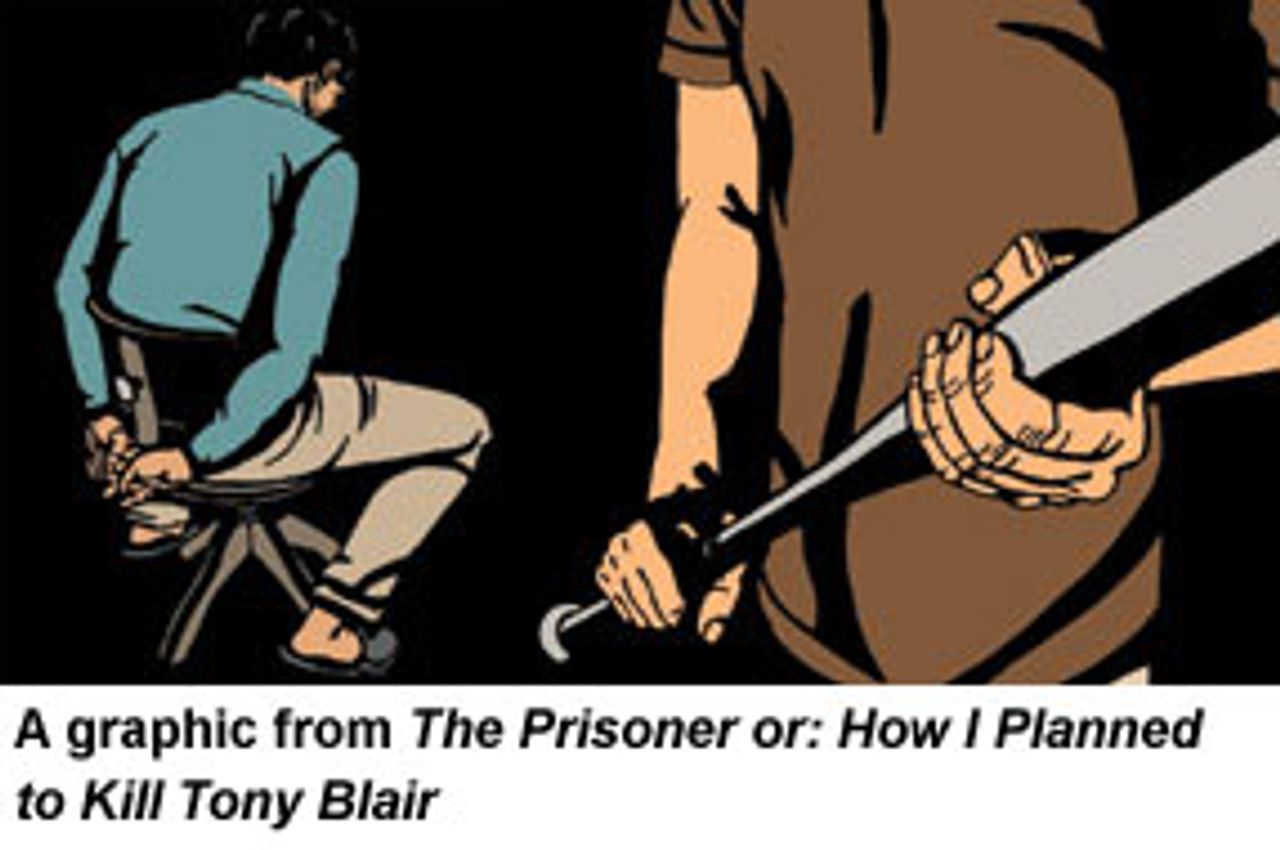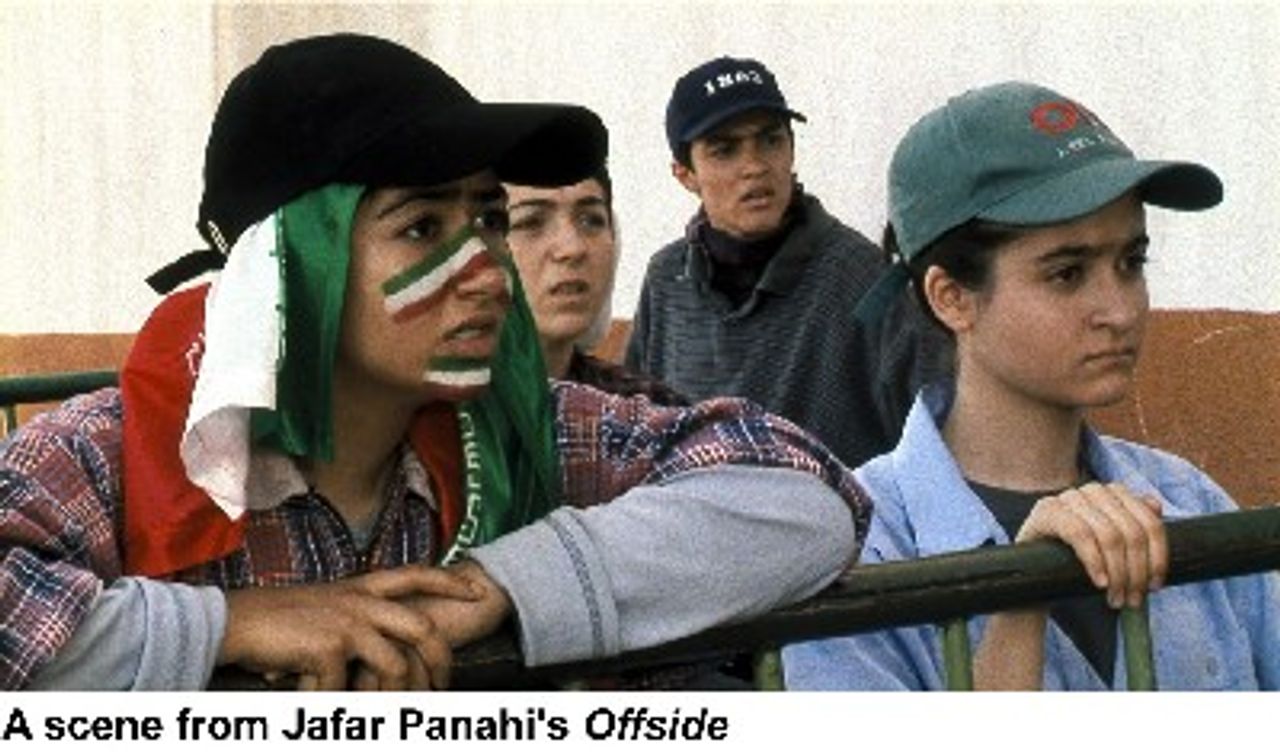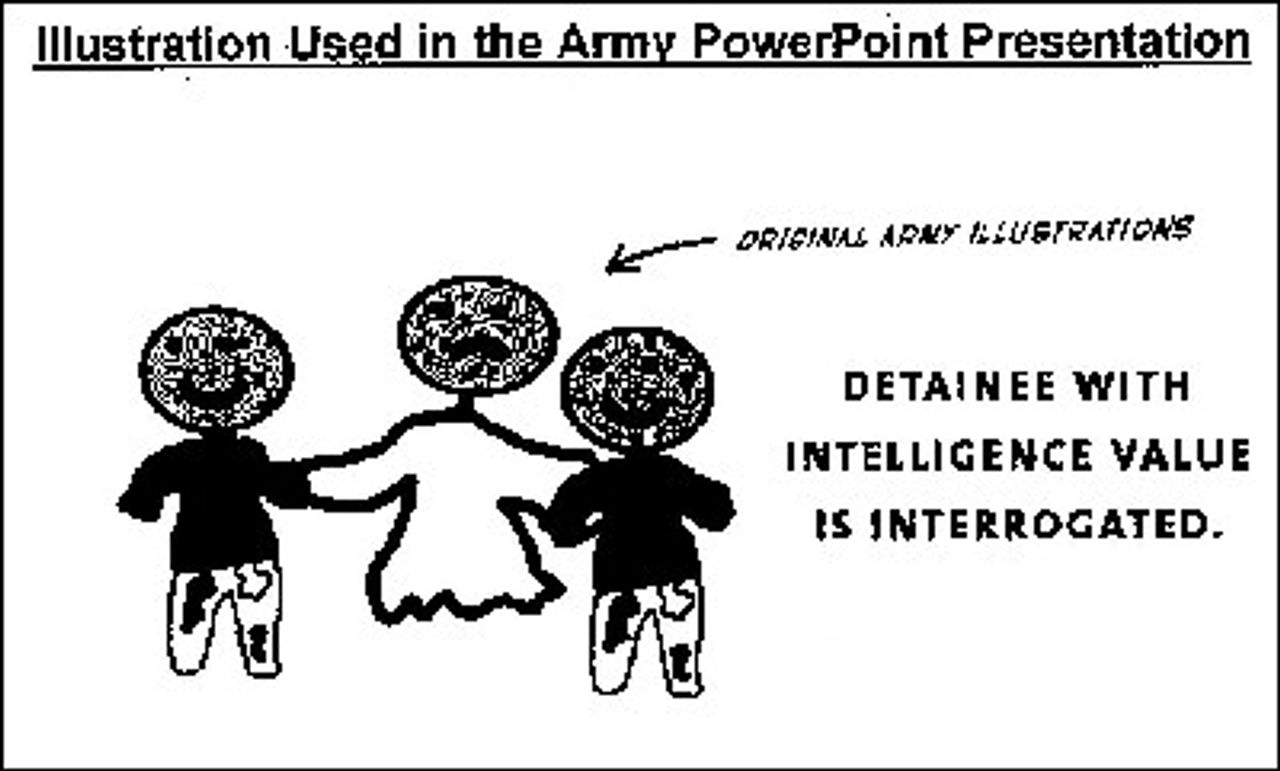This is the third in a series of articles devoted to the recent Toronto film festival (September 7-16).
Toward the end of The Prisoner or: How I Planned to Kill Tony Blair, a documentary by the filmmaking team of Michael Tucker and Petra Epperlein, Iraqi journalist Yunis Khatayer Abbas calmly declares, “I am not terrorist or monster. I am not Dracula. I am not a monkey or cow. I am a man.”
While accompanying members of the US Army’s 2nd Battalion, 3rd Field Artillery Regiment, stationed in Iraq in the fall and winter of 2003-2004 for their documentary, Gunner Palace, Tucker and Epperlein filmed the arrest of Yunis Abbas and his three brothers. The family had just returned from a wedding when the US unit raided their house where Coalition Intelligence claimed four brothers were building bombs for a terrorist cell. Since the family name was Abbas, the officer in command crudely dubbed the action “Operation Grab-Ass.”

As Yunis protests to his captors, in Gunner Palace, telling them that he is a journalist, he and his brothers are cuffed and dragged away. His defiance prompted the documentarians to track him down and discover his fate. This is the subject of The Prisoner.
The film disturbingly recounts what Yunis Abbas endured during his nearly nine-month detention in US hands at two locations, including Abu Ghraib, on utterly bogus charges of plotting to assassinate British Prime Minister Tony Blair (hence the film’s title).
In 1998 Abbas was picked up on orders of Uday Hussein, held for three days, and tortured, for writing a critical poem. After the fall of Baghdad in 2003, he worked as a freelance cameraman and fixer for an independent producer contracted by Britain’s Channel 4. Speaking to the camera, composed, yet visibly shaken and looking as though he had aged appreciably since his involuntary appearance in Gunner Palace, Abbas describes his first arrest and relates it to his even more traumatic imprisonment five years later. Because there is no footage of Abbas’ 2003-2004 detention, Tucker and Epperlein artfully use comic book graphics to illustrate his narration.
The film makes clear that the conditions under which Abbas and others were held by the American forces were horrendous. At one point, Abbas holds up a pair of underwear he smuggled out of Abu Ghraib, having carefully recorded on the material the names and prisoner numbers of fellow inmates who died of myriad causes—from being shot as they protested against the abusive environment to being denied medical treatment.
In the production notes, the filmmakers elaborate: “He [Abbas] talked about Abu Ghraib and how he lived with 4,000 men in the most primitive conditions and how he watched as friends died from neglect, mortar attacks and from gunshot wounds received during the demonstrations the detainees staged to protest conditions. Clearly beyond the pornographic abuse of the Hard Site that most of us have seen, the detainees in the prison suffered from systematic indifference where all were presumed to be guilty.”
Tucker explained the decision to use animation for the scenes of Abbas’ detention, in an interview with greencine.com: “When I first sat down with Yunis, one thing that shocked me in his reactions to things was the cartoon-like violence inflicted upon him and also the cartoon language. Yunis is a very sophisticated person, and I found him to be most emotional when someone called his mother a ‘f—woman.’ He was trying to remember the word ‘whore.’ It was a lot of ‘shut the f— up, shut the f— up, shut the f— up’—grotesque and violent. Comics just felt right for it in that way. Also, his experience was like it happened in a comic book, and also comic. They simply wouldn’t believe him when he was being branded as a terrorist.”
Along these lines, the film shows army documents that include power point presentations using happy/sad-face illustration figures with captions such as, “Detainee Arrives at Abu Ghraib [happy-face for detainee and interrogator]. Screeners assess for intelligence value,” and “Detainee with intelligence value is interrogated [sad-face for detainee, happy-faces for interrogators].”
The filmmakers ask in their production notes, “Was he [Abbas] arrested because of his association with Western journalists who were off-message?” This is more than a remote possibility given his connection with Britain’s Channel 4, which the Americans considered to be a broadcaster of “anti-Coalition messages.” Moreover, American soldiers are shown in the documentary before the raid, commenting that “they [their superiors] want videos and CDs,” suggesting that Abbas’ arrest was aimed at suppressing critical press coverage of the war.
“After making multiple Freedom of Information Act inquiries to the Army and perusing thousands of pages of declassified documents, we still don’t have an answer. The Army claims that Prisoner # 151186 [Abbas] does not exist,” writes Tucker.
A refutation of the Pentagon’s claims that Abbas fabricated stories of his and others’ mistreatment came from an unexpected source. At The Prisoner’s initial screening at the Toronto festival, Tucker read out an email from a US soldier, Spc. Benjamin Thompson, who guarded Abbas for five months at Abu Ghraib, while the latter served as “camp chief,” the prisoner designated by the detainees to deal with the guards. Thompson, who was present at the screening, not only confirmed the existence of Prisoner #151186, but powerfully condemned the US military’s handling of its prisoners in Iraq.
Although worldwide attention focused on the torture of prisoners after the publications of the infamous photos in 2004, Thompson said that less known was the deplorable state of the prisons that housed the thousands of Iraqis deemed by the military to be of no intelligence value. “I wouldn’t have kept my dogs in those conditions,” said Thompson, suggesting gross violations of the Geneva Conventions.
In response to the comment of an audience member that Abbas appeared to exhibit a lack of anger, Thompson replied, “You have to understand what this man has been through. He was dragged out of his house in the middle of the night. He watched people suffer from malnutrition. You can’t understand that kind of anger.”
Sari’s Mother
James Longley’s Sari’s Mother is a 20-minute documentary that chronicles the hardships experienced by an Iraqi mother struggling to get help for her 10-year-old son, afflicted with AIDS. This woman’s story is one of many that Longley filmed in Iraq following the US invasion in March 2003. While his feature-length documentary, Iraq in Fragments (2006), contains three segments, the compelling footage of Sari and his mother was fashioned into a separate movie.
Beautifully filmed, Sari’s Mother documents a social existence reduced to the irrational and primitive by the US occupation. The Zegum family lives in the rebellious Mahmudiyah region in the center of Iraq. American military helicopters whirling overhead disrupt the pastoral landscape. The family is hard-pressed to scratch out an existence, farming land rented from neighbors.
 In an interview in Toronto, director Longley explained that Sari’s father had been injured during the Iran-Iraq war in the 1980s, with his life becoming even more difficult following the 1991 Persian Gulf War. “[At this time], the country in general was going through a very difficult time financially and otherwise,” said Longley. He explained that it was during the sanctions period that Mr. Zegum married and started a family.
In an interview in Toronto, director Longley explained that Sari’s father had been injured during the Iran-Iraq war in the 1980s, with his life becoming even more difficult following the 1991 Persian Gulf War. “[At this time], the country in general was going through a very difficult time financially and otherwise,” said Longley. He explained that it was during the sanctions period that Mr. Zegum married and started a family.
Referring to Sari, the director noted, “Officially there were not many AIDS patients before the war. They were placed in special hospitals. After the war, things fell apart. Many of these hospitals were looted and abandoned; everything was taken, down to the light fixtures.
“Even under the sanctions, there were more medical benefits than there are now. The situation is worse. Whatever health care plans were supposed to be put in place have not been implemented because of the chaos in the country, military and otherwise. During the sanctions period, Iraq obtained low-quality medications from a number of other countries, including India.”
Racing against time, Sari’s mother is desperate to obtain proper treatment for her disfigured and desperately ill son. “Nothing that the United States did after the war was really conducive to putting into place plans for reconstruction and development,” said the filmmaker. “And as the security situation deteriorated primarily as the result of United States policies, the foreign contractors who were, in effect, responsible for doing these things—rebuilding schools, hospitals—were less interested in working in the country, but they had the money, so...”
Mrs. Zegum receives a small stipend for taxis back and forth to the hospital. The hospital is losing money on Sari and the doctors tell his mother to go ask for the equivalent of a $10 increase from the president of Iraq. As she maneuvers through the bureaucracy, Sari’s health deteriorates. Longley explained that the woman is asking for an increase in her stipend on the grounds that the government is responsible for her son’s condition, since it resulted from a blood transfusion administered at a public hospital.
Commenting on the post-invasion situation in Iraq, Longley said: “I don’t think the idea was to establish a ‘democratic’ Iraq, and I say that because that’s not what they [US officials] did. They came in, they had a completely different plan. They brought in these people from the outside, they installed them as a governing council. And then they hired a private company from North Carolina for tens of millions of dollars to establish these local governing councils in every town and village.
“Everything was done by private companies. And then these local councils, which had been installed by the United States, were supposed to select a national parliament. So you would have the indirect selection by the United States, through its contractors, of the national government, which would then produce a constitution and everything else. That was their plan. People said they didn’t have a plan. That was their plan.”
When asked about his thoughts on Iraq’s descent into civil war, Longley replied: “The American occupiers, from the lessons of history—considering what the British did in India, what the French did in Algeria—will get more and more desperate and the attacks will get more and more desperate, and there’ll be more violence.
“As long as you have the United States as an unpopular occupying force supporting the government, that government is not going to be supported by the people. The only way you can stop it is to remove the United States from the region and allow the Iraqis to govern themselves. But as long as the Americans are there, it’s a recipe for dividing the society and having a civil war. It’s possible that [a war against] Iran may be their exit strategy from Iraq.”
It is noteworthy that an increasing number of films are concerned with the US predations in the Middle East, displaying varying degrees of awareness and conscientiousness. Among these, the works of James Longley and Michael Tucker/ Petra Epperlein stand out as some of the most serious and perceptive. The documentarians have risked life and limb to record the reality of the colonial enterprise in Iraq for both its Iraqi and American victims.
As substantial and valuable as the accomplishments are, it would be a mistake not to point to certain limitations. In general, the filmmakers continue to leave a whole number of critical questions unanswered, including the history of the region, the driving forces of the American intervention, the roots of Islamic fundamentalism and the associated political problems in the Middle East. The films are clear-sighted and intelligent, and winningly crafted, but narrow in their scope.
One is tempted to say, deliberately narrow. And this tendency seems associated with some of the weaknesses of the prevailing contemporary documentary style, which eschews any kind of political analysis or generalization. According to this outlook, the filmmaker simply records the immediately given, makes no judgments, offers little or no perspective. ‘Let the facts speak for themselves.’
In reality, facts rarely speak for themselves, although they do inevitably speak to something. Every time the camera rolls and film or video is edited, a polemic is being made. Insofar as the work is not consciously undertaken, there is an unavoidable tendency to reflect one aspect or another of the prevailing attitude or confusion. It’s time for documentary filmmaking to take a look at itself and dare to draw some profoundly critical conclusions about the world.
Offside
Inspired by the occasion when his daughter was refused entry to a football stadium, Iranian director Jafar Panahi’s Offside follows six girls who try to sneak into the Iran-Bahrain World Cup qualifying match in Tehran. They are obliged to “sneak in” because females in Iran are forbidden to watch live football, on the grounds of its corrupting influence—bad language from fans, half-naked athletes, etc. One by one the girls are caught, despite, in many cases, ingenious disguises (one has appropriated a military officer’s uniform).
They are placed in a holding pen and guarded by military conscripts, mostly young men from the countryside, who have their own frustrations and grievances with the political system and their mandated military service. United by their obsessive desire for Iran to beat Bahrain and their common class oppression, the movie’s characters, despite their opposing views on women’s rights, rally together.

Although amusing, Offside points to a darker reality. Social suffocation provokes a defiance of repression which takes daring and inventive forms. Each of the girls risks a great deal to attend a football game. This willingness to stake so much for apparently so small a prize, hints at the explosiveness of the social contradictions in Iran, where a quasi-medieval political elite is pitted against a sophisticated (and statistically youthful) population.
Speaking to Time Europe, Panahi observed that he regarded himself “as a social filmmaker, not a political filmmaker. But every social film, at its base, comes into contact with political issues. Because every social problem is clearly due to some political mistake.” Whether or not one agrees with Panahi’s precise formulation of the issue, there is no doubt that he has been one of the most articulate voices of social protest in the Iranian cinema.
In this light, compared to his most recent films, The Circle (2000), which features intertwined stories of female oppression, and his brilliant Crimson Gold (2003), a taut exposé of social inequality, Offside appears somewhat slight.
A glimpse at the difficulties that Panahi faces with Iranian government censorship perhaps puts this “slightness” in context. It might also help explain (if not excuse) the apparent concessions he makes to Iranian nationalism at the conclusion of his film, a lengthy patriotic celebration of Iran’s victory in the qualifying match, complete with a rendition of the national anthem, “Oh land of jewels, your soil is the wellspring of the arts.”
Denied a license to make his film, Panahi submitted a phony synopsis to the authorities under a false name. Although he obtained the ministry’s approval, he was not provided the usual funding and equipment doled out to major filmmakers, obliging him to work with only a digital camera and a small crew. Moreover, five days before the scheduled completion of the movie, Tehran police were instructed to arrest the director on sight if they spotted him filming. “Luckily, the only scenes we had left were in a minibus, so we drove out of the city borders where they couldn’t find us,” explained the director to Time Europe.
An article on the Qantara.de web site exclaimed that “One can only hope that the Iranian censorship authorities judge the patriotic tone of the film as an important point in its favor.” No such luck! Offside has been banned in Iran. This is nothing new for Panahi. The Circle remains censored in Iran, and Crimson Gold had twelve scenes cut.
In an interview with opendemocracy.net, Panahi discussed another dimension of Offside: “This element of masquerade [females attired as males] is a general characteristic of all the films made in Iran. They have different layers of meaning and messages. This is what annoys the authorities—and the same is true for television, which in Iran is wholly state-owned. So it’s not just that the authorities don’t like the message, they don’t even want to have the questions raised in the first place. The very raising of the issue of women and their status in society and their desire to go to a football match—this is something which challenges the authorities, and they don’t have the sufficient strength of character or tolerance to handle it.”
To be continued

